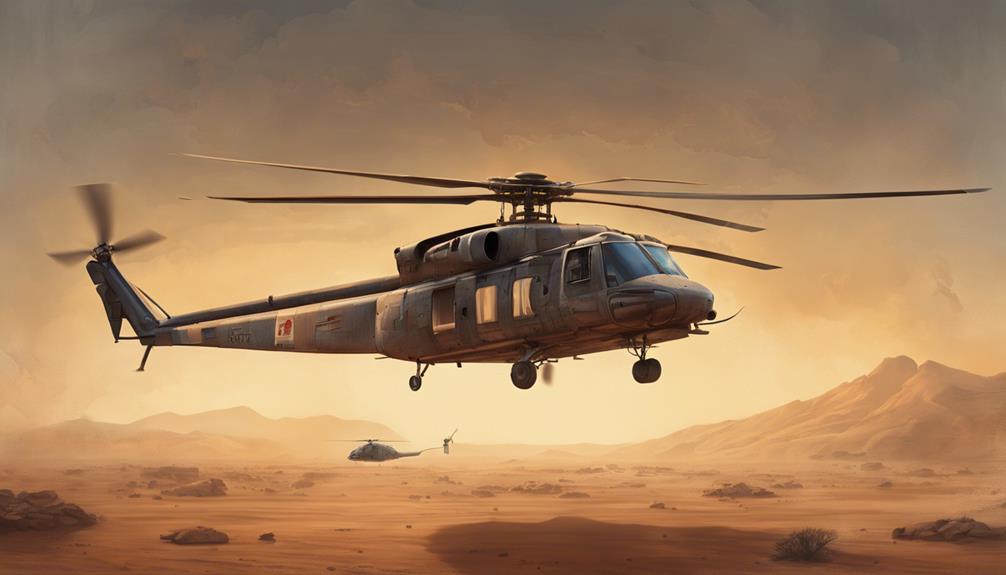You've heard military personnel referring to helicopters by nicknames like 'Huey' or 'Loach', but where did these slang terms come from? In military culture, helicopters are often nicknamed based on their characteristics, roles, or personalities. For instance, the Bell UH-1 Iroquois is commonly called the 'Huey', while the Hughes OH-6 Cayuse is nicknamed the 'Loach'. These unique nicknames provide insights into the capabilities and characteristics of each helicopter. As you explore military helicopter operations, you'll uncover more slang terms and acronyms that reflect the rich culture of military aviation – and there's more to discover.
Choppers in Combat Zones
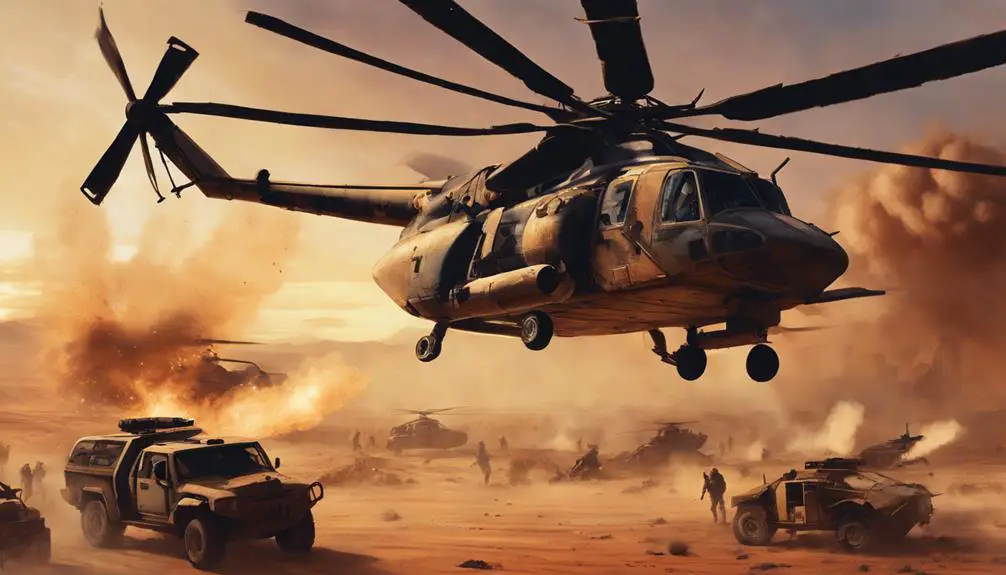
Flying into combat zones, you've likely heard the rotor blades of choppers, an indispensable asset in modern warfare. In combat deployment, helicopters play an essential role in transporting troops, supplies, and equipment. They're also used for reconnaissance, medical evacuations, and search and rescue missions. Helicopter warfare has become a pivotal component of military strategy, allowing for swift and agile responses to enemy movements.
In the heat of battle, choppers provide close air support, firing rockets and machine guns to soften enemy defenses. They also serve as airborne command centers, directing ground troops and coordinating artillery strikes. The versatility of helicopters in combat zones cannot be overstated, allowing military commanders to adapt quickly to changing circumstances on the battlefield.
In modern warfare, the importance of helicopters in combat deployment cannot be overemphasized. They offer a unique combination of speed, maneuverability, and firepower, making them an essential tool in the military arsenal. As you experience the sounds of choppers in combat zones, remember the critical role they play in supporting ground troops and securing military objectives.
Huey and Its Variants
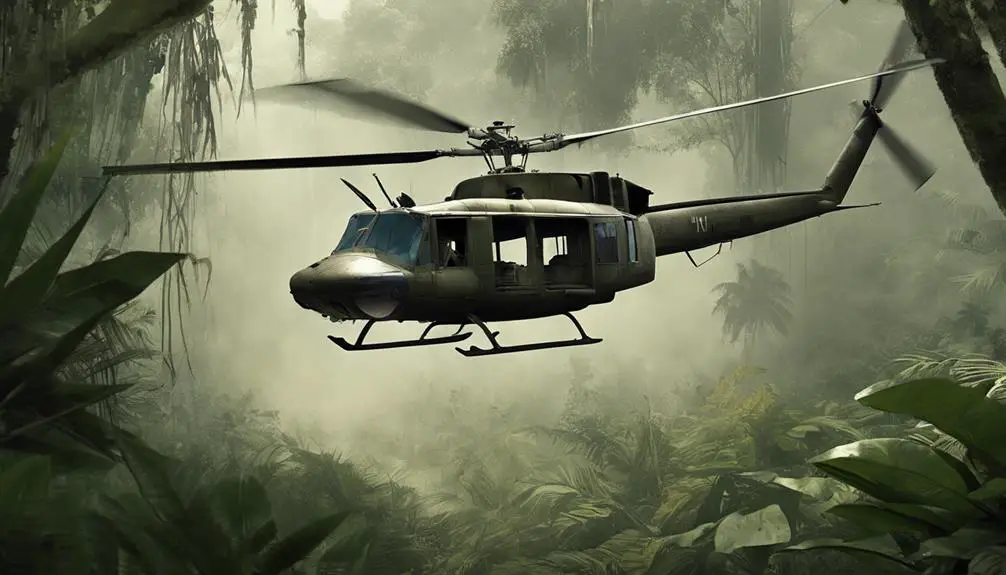
Your introduction to military helicopters likely started with the iconic Bell UH-1 Iroquois, affectionately known as the Huey, a workhorse that's been serving in various capacities since the early 1950s. You're probably familiar with its rugged design and versatility, which made it an ideal choice for military operations. But did you know that the Huey has undergone significant evolution over the years?
The Huey's history is a proof of its adaptability. Initially designed for medical evacuation and transport, it soon found itself in combat zones, serving as a gunship and troop transport. The Huey's evolution led to various variants, each tailored to specific roles. The UH-1A, for instance, was optimized for medical evacuation, while the UH-1C was designed for cargo transport. The Huey's versatility didn't go unnoticed, and it soon became a staple in military operations worldwide.
Throughout its history, the Huey has seen numerous upgrades, from improved engines to advanced avionics. Its durability and reliability have made it a trusted companion for military personnel, earning it a revered place in military history. As you explore further into military slang, understanding the Huey's significance will give you a deeper appreciation for the world of military helicopters.
Bird Nicknames and Origins
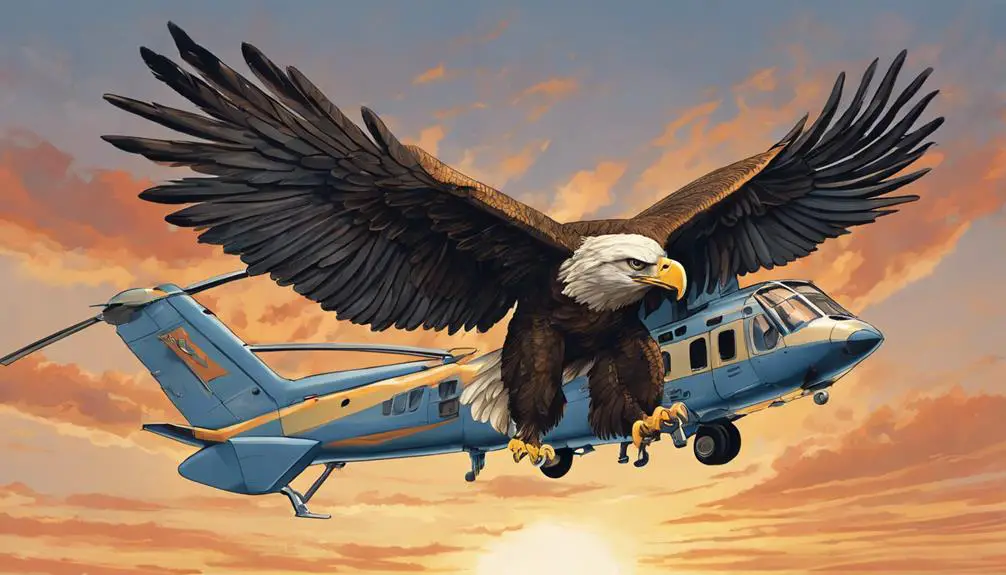
In military slang, helicopters are often referred to by nicknames that reflect their appearance, function, or quirks, and exploring these 'bird' nicknames can reveal interesting stories about their origins and characteristics. You might've heard of the 'Huey' or 'Cobra,' but what about the 'Loach' or 'Chinook'? These nicknames are woven into the fabric of rotorwing culture and are a tribute to the rich helicopter heritage.
As you investigate the world of military helicopters, you'll discover that each nickname has a unique story behind it. Take the 'Loach,' for instance, which got its name from the LOH (Light Observation Helicopter) designation. The 'Cobra,' on the other hand, was nicknamed for its aggressive, snake-like appearance. Understanding these nicknames can give you insight into the design, capabilities, and even the personalities of the people who flew them.
Whirlybird Lingo Explained
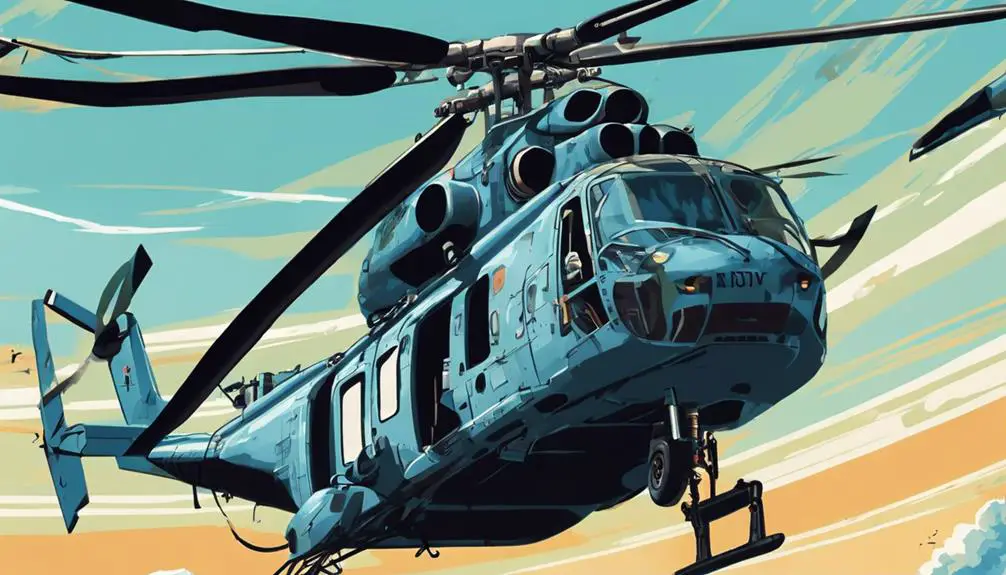
From the 'Huey' to the 'Cobra,' you're probably familiar with some of the more common military helicopter nicknames, but do you know what they mean or how they originated? These nicknames, known as 'whirlybird lingo,' have evolved over time, reflecting the cultural and operational nuances of military aviation.
As you explore further into the world of military helicopters, you'll notice that pilot lingo has undergone significant changes, influenced by advances in technology, changes in operational environments, and the need for more effective crew resource management. For instance, the term 'Whirlybird' itself emerged during the Korean War, referring to the early Sikorsky helicopters. The 'Huey' nickname, on the other hand, originated from the Bell UH-1 Iroquois helicopter's designation, with 'H' being the phonetic alphabet equivalent of 'Huey.' Understanding these nuances can provide valuable insights into the world of military aviation and the people who operate these complex machines.
Military Helicopter Codes
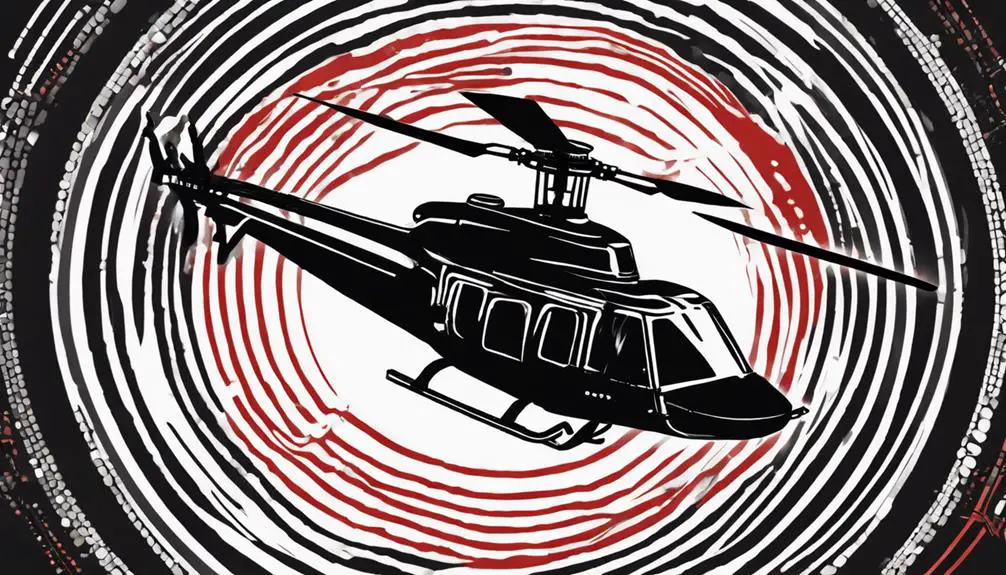
You'll often hear military helicopter codes like 'Hawk' or 'Snake' being used over the radio, but what do these codes mean, and how do they enhance communication among pilots and ground crew? These codes are part of a standardized system of helicopter identification codes, used to quickly and clearly identify specific aircraft over radio communication. Each code corresponds to a specific type of helicopter, ensuring that messages are conveyed efficiently and accurately.
The NATO phonetic alphabet is also used in radio communication to avoid confusion between similar-sounding letters. For instance, the letter 'A' becomes 'Alpha', 'B' becomes 'Bravo', and so on. This system helps pilots and ground crew to clearly understand critical information, such as coordinates, call signs, and instructions.
Using these codes and the NATO phonetic alphabet, military personnel can quickly and accurately communicate essential information, even in high-stress situations. By adopting a standardized system, the risk of miscommunication is notably reduced, ensuring that operations run smoothly and safely.
Rotorcraft Radio Callsigns
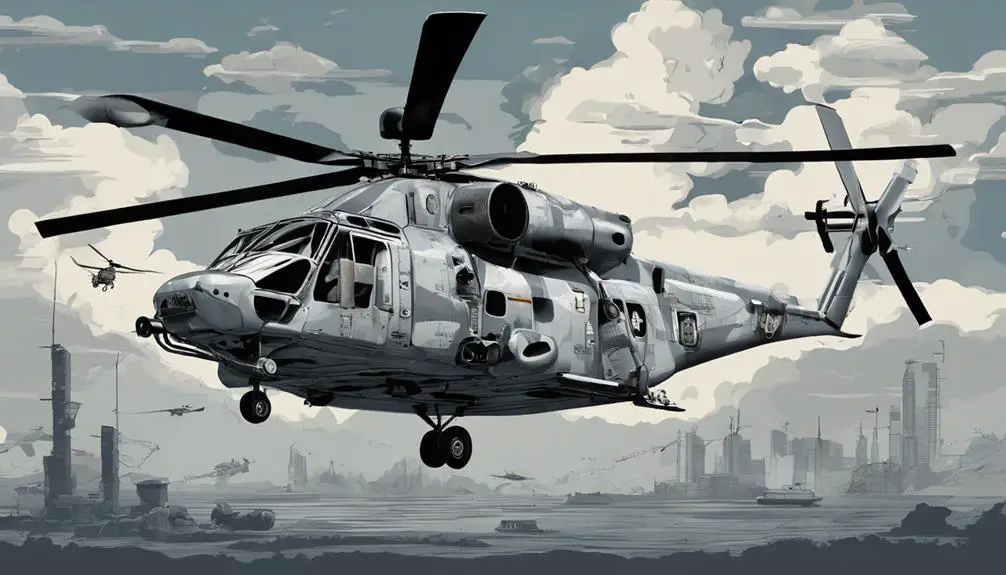
When communicating over the radio, military helicopter pilots and ground crew use unique radio callsigns to identify themselves, which are typically composed of a combination of letters and numbers. You'll notice that these callsigns are standardized across different military branches and countries, ensuring clear communication during joint operations or international exercises. This standardization is the result of radio protocol evolution, which has led to the development of specific formatting guidelines for callsigns.
For rotorcraft, callsigns usually consist of a combination of a country code, unit identifier, and mission designator. For example, a US Army helicopter might use "ARMY-123-ALPHA" as its callsign. This format allows for quick identification of the aircraft's origin, unit, and purpose, facilitating efficient communication and coordination. Call sign standardization has become increasingly important as military operations have become more complex and multinational. By using standardized callsigns, military personnel can quickly identify and respond to transmissions, ensuring seamless communication in high-stress environments.
Slang for Helicopter Types
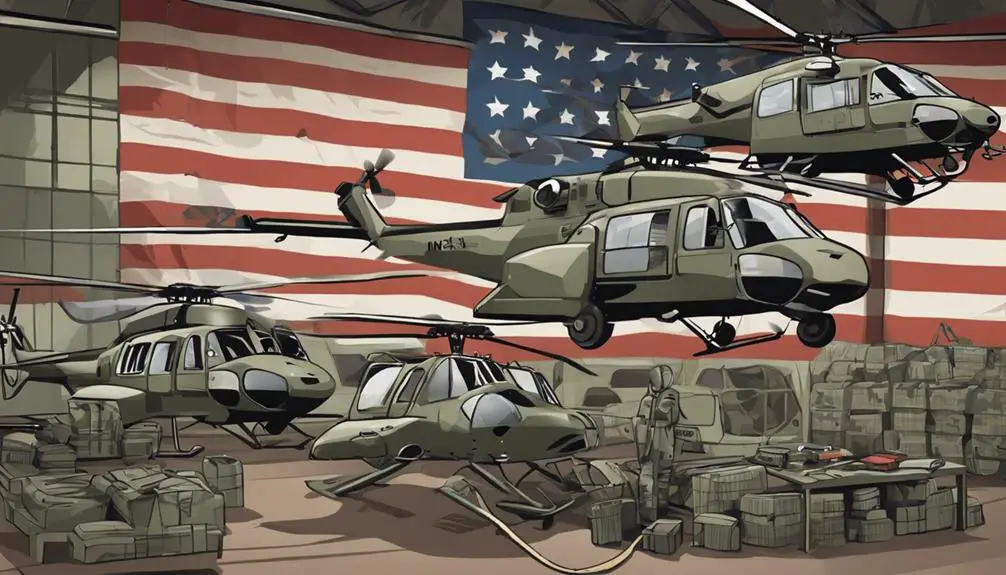
In military circles, you'll often hear helicopters referred to by colloquialisms or nicknames that reflect their appearance, role, or capabilities. These slang terms can vary depending on the helicopter's type, function, or the unit it's assigned to. For instance, the UH-60 Black Hawk is often called a "Hawk," while the AH-64 Apache is referred to as a "Snake." These nicknames can be specific to certain units or branches, but they're widely recognized across the military.
Some helicopters are nicknamed based on their role or capabilities. For example, helicopters used for Helicopter Insertion Tactics, such as the MH-60M Black Hawk, might be called "Assault Hawks." Others, like the MH-47G Chinook, might be referred to as "Heavy Hooks" due to their heavy-lift capabilities. Rotorcraft Mission Profiles also influence the slang used to describe helicopters. For instance, medical evacuation helicopters might be called "Dustoff" or "Medevac," while those used for transport or logistics might be referred to as "Trash Haulers." Understanding these slang terms can help you better communicate with military personnel and understand their operations.
Aviation Acronyms Decoded
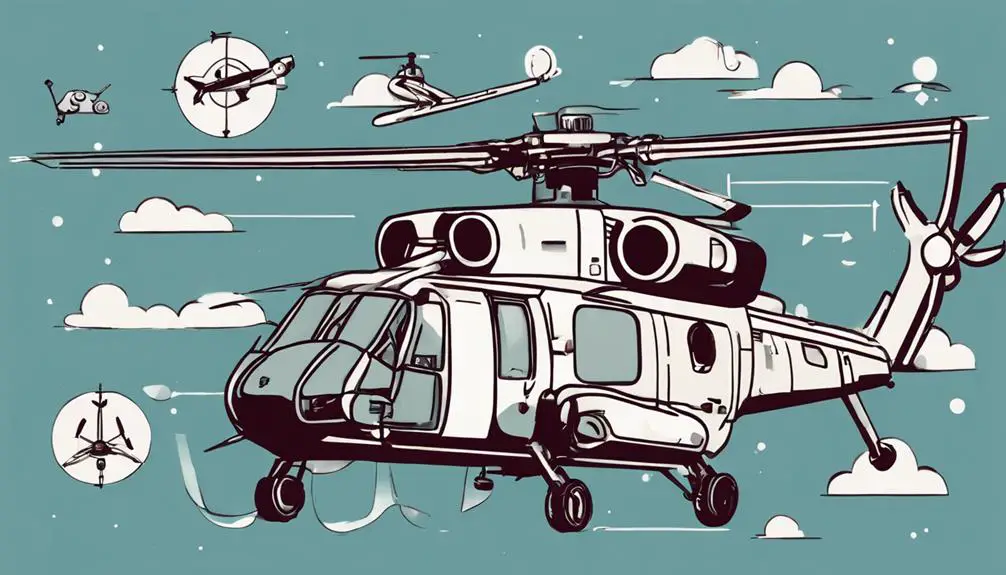
As you're familiar with the various nicknames for helicopters, it's equally important to understand the abbreviations and acronyms that are commonly used in military aviation, as they're often used to convey critical information quickly and efficiently.
Flight deck abbreviations, for instance, are used to identify specific aircraft or systems on board. You'll often come across abbreviations like 'COMMS' for communication systems or 'NAV' for navigation systems. These abbreviations help pilots and aircrew communicate complex information quickly and accurately.
Aircraft identification codes are another set of acronyms you'll encounter. These codes, like 'AH-64' for the Apache helicopter or 'UH-60' for the Black Hawk, are used to identify specific aircraft types. These codes are essential in military aviation, as they help pilots, air traffic controllers, and ground crew quickly identify and communicate about specific aircraft.
Understanding these aviation acronyms and abbreviations is critical for effective communication in military aviation. By familiarizing yourself with these codes and abbreviations, you'll be better equipped to navigate the complex world of military aviation.
Frequently Asked Questions
Can Civilians Use Military Slang for Helicopters in Everyday Conversation?
Did you know that 71% of Americans use slang daily? When it comes to using military slang for helicopters in everyday conversation, you might want to think twice. Emphasizing the importance of respecting conversational norms and avoiding using terms that might come across as insensitive or pretentious. Stick to common language to avoid confusion and maintain clarity in your communication.
Are All Military Helicopter Codes Classified or Publicly Available?
You might assume all military helicopter codes are classified, but that's not the case. While some codes remain classified, others are publicly available. Declassification timelines vary, with some codes becoming public after a certain period. Code availability also varies, with some countries making their codes freely accessible, while others restrict access. You'll find that some military helicopter codes are even published online, making them easily accessible to the public.
Do Military Pilots Use Helicopter Slang in Formal Flight Reports?
When writing formal flight reports, you typically stick to standardized language, avoiding slang or colloquialisms. However, there are formal language exceptions where pilots may use specific terminology or abbreviations. Report writing nuances, like clarity and concision, still apply. You'd focus on conveying critical information efficiently, rather than incorporating informal slang.
Are There Regional Differences in Helicopter Slang Within the Military?
You've heard how different accents and phrases can give away someone's hometown, right? It's similar with military helicopter slang. Regional dialects and geographic variations exist, even in the military. For instance, in the Navy, "helo" is commonly used on the East Coast, while "chopper" is preferred on the West Coast. These differences are not just limited to the US, as international militaries also have their own regional slang.
Can Military Helicopter Slang Be Used in Commercial Aviation Contexts?
You're likely to find that military helicopter slang isn't directly applicable in commercial aviation contexts. The lingo is often specific to military operations, and using it in commercial aviation could lead to confusion. Stick to standardized aviation terminology to guarantee clear communication with air traffic control and other crew members. It is crucial to use universally understood terms to maintain safety and efficiency in commercial aviation.

